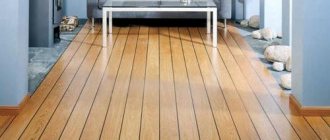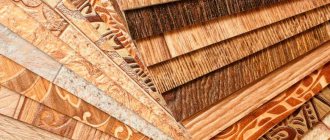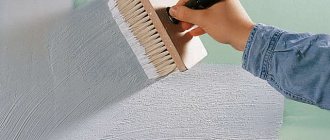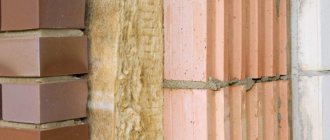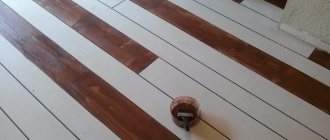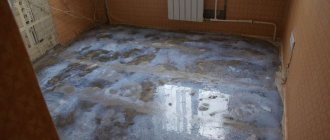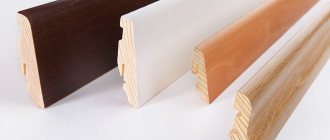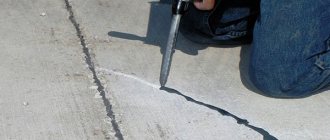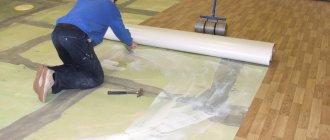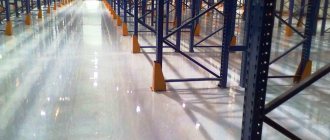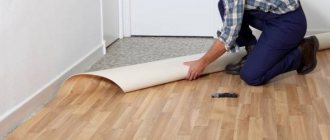Repair compounds for concrete can eliminate deformations and chips in structures. The products are used in different seasons, withstand changes in temperature conditions, are resistant to high humidity, the effects of fungus and mold, have good adhesion and rapid setting of the composition.
The list of popular products includes products from the brands Emaco, Consolit Bars, Birss, Siltek, Knauf, Mapei.
Difficulties of the concrete repair process
Repair of concrete surfaces using mortar or dry mixtures is required when the reinforcement is exposed, the material is destroyed, or the surface cracks down to the crushed stone filler. In the absence of restoration work, the structure may collapse.
There are the following difficulties in repairing concrete structures:
- cement grain has a dense structure and does not absorb liquids, solutions, standard masonry composition does not adhere to the base;
- The typical repair mixture shrinks and peels off on a concrete base.
To restore the integrity of the surface, specialized mixtures are used that are characterized by plasticity, a high degree of adhesion, and strength.
The product formula includes the following basic principles:
- dry polymer-cement and ready-made compositions;
- fibropolymer compounds consisting of sifted sand, acrylic and cement;
- compositions with epoxy resins.
What and how to tighten houses from cracks in the walls
If the wall of a brick house is cracked, you need to make a cement mortar. The entire volume is filled with it, the mesh is laid, then the mixture is added again. If the hole is large, this is not enough - simply removing it will not work, so the walls of the house need to be tightened. The specific technology depends on the cause and nature of the damage:
- If a large vertical defect is found, it must be removed using holes. They are drilled into a brick wall and then metal fasteners are inserted. In this case, reliable steel beams are used, which are connected using special pins. But if the damage is very large, on the order of several centimeters, they can only be removed by first replacing the masonry.
- If the crack is horizontal, it can be removed using special metal plates. They are installed in the gap so that a joint is formed in the form of a seam.
- If damage occurs simultaneously vertically and horizontally, use steel staples. First, holes are punched in the walls, and then the metal elements are fixed. The final fastening is done using steel strips. They are placed at intervals of 1.5 to 3 m. Fixation is carried out with anchors, holes for which are drilled at intervals of 80-120 cm.
The screed is made using metal fasteners
Classification
Repair composition for sealing cracks in concrete is divided into the following types:
- injection molding;
- dry.
To adjust the characteristics, plasticizers, granular fillers, modifying additives, etc. are added to the mixture.
According to the complexity of the composition formula, products are divided into the following subtypes:
- one-component - cement-based with filler of different granularity levels;
- two-component - epoxy differ in the degree of density, ductility and fluidity;
- multicomponent - based on polyurethane, have a liquid consistency.
According to the level of compression, products are divided into the following subtypes:
- shrinkage;
- non-shrinkable.
According to their functional purpose, the following subtypes are provided:
- for structures with high mechanical loads - ceilings, load-bearing wall panels, beams, pillars;
- compositions for protecting reinforced concrete structural elements from corrosion, the appearance of fungus, and damage from mold;
- Products with increased strength for the restoration of road surfaces and building screeds provide additional protection in winter.
According to the conditions of use, products are divided into the following subtypes:
- casting - for horizontal surfaces;
- thixotropic - for correcting unevenness on wall panels;
- frost-resistant - for external repair work;
- quick-hardening - for urgent repair work, eliminating leaks.
Fast acting mixture
Fast-acting concrete repair mixtures harden and dry quickly. The use of heavy loaders is permitted 30 minutes after application of the composition. The mixtures are suitable for a concrete layer no larger than 40 mm. The materials are used for emergency repairs in warehouses, in places where equipment is not allowed to remain idle.
Non-shrink repair product
Shrinkage occurs when the volume of cement stone in the solution decreases during the evaporation of water from the adhesive composition. Deformations can lead to the formation of cracks and chips. A special non-shrinking composition prevents destruction of the concrete base.
The formula of the product includes additives with a special reagent to expand the mass.
The solution is plastic, does not separate, does not shrink and sets quickly. The compositions are suitable for different types of bases, are strong, durable, and are highly expensive.
Thixotropic mixture
The thixotropic mixture is intended for repairing blocks, wall panels on a slope, and horizontal surfaces. When using the product, no auxiliary lathing is required; the product has a high viscosity that prevents spreading outside the treated area.
The dry mixture is based on durable cement powder, mineral fillers, and modifying agents. The mass also includes reinforcing fibers.
After dilution in water, a strong solution is formed that does not create shrinkage. The thixotropic mixture must be applied in a dense layer. For stability in places with heavy loads, reinforcing bars will be required. After hardening, the composition becomes resistant to compression and bending, and vapor permeable.
The product is intended for professional repairmen and restoration work in private buildings.
When used professionally, the mixture is suitable for the following areas and types of structures:
- restoration of damaged surfaces, structural repairs in the event of reinforcement corrosion;
- to eliminate defects that arose during construction;
- to restore the protective layer;
- for filling thin seams;
- for leveling wall panels and fences;
- for mounting foundations exposed to strong mechanical loads;
- for waterproofing work on the roof;
- for repairing boiler houses, thermal power plants, bridges, chimneys, viaducts;
- for restoration of ceilings in basements.
In private construction, compositions are used in the following cases:
- repair of concrete floors, paths, floors, staircases, basements, vegetable stores;
- sealing cracks, chips, grooves;
- restoration of garages;
- repair of structures subject to dynamic loads.
Thixotropic repair materials are not used for finishing smooth surfaces and are not suitable for anchoring or preparing formwork. The installation temperature must exceed +5°C. The thickness of 1 coating reaches 30-35 mm, after 28 days the compressive strength reaches 60 N/mm², elasticity parameters are 25,000 N/mm².
Frost-resistant
Frost-resistant compounds are used to repair concrete outdoors. The product can withstand sub-zero temperatures and temperature changes. The formula of the mixture contains polymer compounds, minerals, fractionated sand, modifying fillers, Portland cement, etc.
The product is used for repairing brick and concrete buildings, cracks in floors, technological holes, restoring smoke, boiler houses, thermal power plants, prefabricated reinforced concrete structures, plinths, for waterproofing building foundations, eliminating defects in monolithic structures, etc.
Causes of cracks in brick walls
Before you remove a gap in the wall, you need to determine the reasons for its appearance. They can be divided into two groups - violations of building codes or improper operation of the premises. If the building is many years old, the wall may also begin to crack. But usually this happens only after 100 years or more.
Most often, the defect is associated with the following factors:
- Design errors - you have to remove cracks in the wall if, when planning the building, you incorrectly assessed the soil structure, groundwater level, and freezing depth.
- Incorrect type of foundation or violation of laying technology, including calculation of width and depth.
- Lack of drainage system or its discrepancy with the groundwater level.
- There is no reinforcement in the load-bearing wall - in this case, defects will also appear, and they will have to be removed.
- Changes were made to the structure, such as adding a basement, but the foundation was not strengthened.
- If the composition of the masonry mortar is incorrect, it will not withstand the load, and then there will be cracks in the wall that will have to be removed.
- The absence of a sand-crushed stone cushion or its poor-quality compaction.
Major defects appear due to errors during the construction of a house
Causes of horizontal cracks in a brick wall
Horizontal cracks in the wall are no less dangerous than vertical ones. As a rule, they are associated with subsidence of the foundation in the center. They do not pose a direct threat to the structure, but repairs are noticeably more difficult. If you do nothing, the wall will literally begin to creep away.
Typically, horizontal defects are observed in new buildings, since shrinkage inevitably occurs in the first years after construction. Residents begin making repairs, applying plaster and other materials, the weight of which becomes an additional factor. For this reason, it is better for residents of the first floors to wait 2-3 years and only then begin renovation work in the apartment.
Manufacturers
The list of popular repair compounds includes products from the following manufacturers:
- Ceresite;
- Penetron;
- Basf;
- Birss;
- Consolidated Bars;
- Siltek;
- Knauf;
- Industry;
- Mapei.
Ceresit
The manufacturer Ceresit produces different types of building mixtures for concrete foundations. The Ceresit CX5 mixture is a restorative mixture, suitable for repairing concrete structures at high humidity. The product does not shrink significantly when hardened and used, and can withstand changes in temperature conditions. The coating is resistant to high humidity and reliably hides defects. The cost of the composition is high - about 2500-3000 per package of 25 kg.
The composition of Ceresit CN 88 is intended for leveling floor coverings and is durable. The product is laid out in a layer of 5-50 mm and can be used indoors and outdoors. The mass is quickly leveled, the surface can be used 6 hours after restoration. The product is wear-resistant, suitable for mechanized spraying, and environmentally friendly in composition.
The product is suitable for leveling screeds and restoring foundations that can withstand high loads. The mass is suitable for manual application to the coating.
The minimum layer thickness is no less than 35 mm; on the sound and heat insulating layers, the product is laid out with a thickness of no less than 45 mm. Can be used as a base for laying finishing material.
Penetron m500 bond mixture
Concrete repair compositions from the Penetron brand are dry mixes. The formula contains processed quartz sand, fine-grained Portland cement, polymer compounds to improve the elasticity of the product, and mineralized fiber fibers. The mixture must be diluted in the proportions of 170 g of water per 1 kg of powder. Laying the mass is carried out at a temperature of at least +5°C. The surface must be washed with clean water.
The product is laid out in a thickness of 5-35 mm, consumption is carried out in proportions of 1.8 kg per 1 m². The composition can be laid out in several layers, the second coating is applied after 4 hours. It takes 120-150 minutes for the layer to harden. After 28 days, the patch increases water resistance to W14, the strength category is 50 MPa, the adhesion level is up to 1.3 MPa.
Blend Parade
Parad brand compositions are intended for urgent repairs of concrete structures; the coating thickness can reach 60 mm. Laying can be done at a temperature not lower than +5°C. The advantage of the product is the rapid setting of the composition and the high strength of the patch.
After 1 day, the strength of the layer reaches 20 MPa; after 1 month, the coating acquires a strength parameter of 70 MPa, the frost resistance level is F200.
The product is universal, suitable for different types of structures (anchors, foundations, joints, road slabs, hydraulic structures, drinking water tanks).
Emaco
Repair mortar for concrete floors Emaco brand Basf is used for structures of various levels of complexity. Emako N 5100 is suitable for minor deformations (cracks, chips). Products N 900 and N 5200 are suitable for eliminating defects of medium complexity (cracks, collapsed areas).
Products S 5400, S 488 are used to eliminate damage due to the corrosion process, closing cracks up to 40 mm. The company also offers compositions for damaged concrete surfaces with exposed reinforcement bars and large chips.
The manufacturer has developed frost-resistant, non-shrinking, anti-corrosion compounds. The price in Moscow is 850-1800 rubles. for 1 package.
Birss Russia
The concrete repair mixture from the Birss brand is universal and can be used for surfaces of different levels of complexity. Products 28, 29, 30, 30N are applied to eliminate cracks and deformed coatings. Special products (30С1, 59С2 and 58С1) are intended for medium wear surfaces; mixtures 59S3, 59Ts, RSM, RBM, 600VRS are used in case of major damage to structures.
The compositions have frost-resistant characteristics, are used at sub-zero temperatures, have high strength of bonding of elements, have water-resistant characteristics, high density, and plasticity.
Consolid Bars
Products for surface restoration Consolit Bars are suitable for panels located vertically and on floor coverings; the mass quickly holds surfaces together, does not shrink, and has high adhesion. The product line includes self-leveling, thixotropic (for restoration of wall panels), finishing, waterproof and reinforcing mixtures. The cost of production is 800-1500 rubles. per package 30 kg.
Knauf
Products for concrete repair from the Knauf brand are environmentally friendly, do not contain toxic substances, are durable, provide surface waterproofing, and have water- and vapor-proof characteristics. The mixtures are sold in compact packages (5-6 kg). The products are universal and are used for external and internal repair work. The cost of packaging (5 kg) is 350-500 rubles.
Industry
Indastro products are universal and are used for repairs, restoration of structures on foundations, restoration of road surfaces, etc. The composition ensures strong joining of elements, is durable, wear-resistant, does not have strong shrinkage, is water-resistant, and frost-resistant.
Mapei (Italy)
The mixture from the Mapei brand ensures that restoration work can be completed in a short time, does not shrink during hardening, does not deform, and prevents abrasion of surfaces. The special SW series is suitable for reinforced concrete structures and is resistant to temperature changes, precipitation and moisture. After hardening, the coating layer acquires anti-corrosion properties and is suitable for waterproofing work.
The manufacturer's range also includes mixtures:
- epoxy;
- with the addition of resins;
- with high plasticity;
- for repairing cracks;
- for restoration of ceilings;
- for repairing airfield ceilings, tunnels, production workshops, highways.
The product price is about 850-1500 rubles.
Mount Crystal
Mountain Crystal products are intended for the reconstruction of concrete floor surfaces, reinforced concrete floors, walls lined with foam concrete and aerated concrete blocks. The mass is used to seal cracks and placed in areas of chips, holes, voids and traces of erosion. The product is suitable for restoring walls, floor coverings, and ceilings.
Siltek
The manufacturer Siltek offers a composition for repairing defects in surfaces and finishing seams between panels. The materials are frost- and water-resistant, quickly harden, durable, and wear-resistant. Reinforced microfibers are included in the formulas of some products. Products are certified.
The particle size in the mass reaches 2.5 mm, the thickness of the coating reaches 30 mm, after 3 days the strength of the layer reaches 15 MPa, after 28 days - 35 MPa. The product is suitable for use within 30 minutes after dissolving in water.
Frost resistance parameters reach at least 200 cycles, shrinkage does not exceed 1.2 mm/m, abrasion characteristics do not exceed 0.5 g/cm2.
The permissible operating temperature is -30…+70°С. After 3 days, the bending strength parameters reach 3 MPa, after 28 days - no less than 5 MPa. The strength of bonding to the surface is not less than 2.0 MPa.
Technologies for eliminating major damage
There are several technologies that can help repair major damage in concrete structures.
Injection
This technology is used to restore the integrity of structural elements in basements, tunnels, foundations, especially block-type ones. Its essence is that the gap is filled with repair mortar under strong pressure. For this purpose, special equipment is used - injection pumps (manual models are produced for everyday use), packers - tubes. With their help, the filler is introduced into the hole.
How to choose?
When selecting products, the following parameters must be taken into account:
- type of repair required;
- extent of damage;
- permissible loads on the base;
- location (indoor or outdoor);
- safety, no toxic particles;
- thickness of the mass laying layer;
- volume of raw materials;
- level of protection against ultraviolet radiation;
- shrinkage characteristics;
- resistance to chemicals and sub-zero temperatures.
When choosing the type of product, it is important to consider the following recommendations from experts:
- it is better to strengthen panels located vertically with thixtotropic mixtures, since the products have a thick consistency and hold securely during operation;
- compositions for leveling the surface must have a high adhesion rate;
- The setting period of the mass should be short.
Application practice
Concrete structures are destroyed if the proportions of substances are not observed, manufacturing technology is violated, due to mechanical deformations, or exposure to the external environment.
The use of special compounds is required in the following cases:
- chips;
- recesses;
- holes exposing reinforcement;
- cracks larger than 0.5 mm;
- intensive dust formation;
- corrosion process in the foundation (deep or surface);
- defects larger than 0.3 mm.
Self-production
You can make a repair composition for concrete yourself for work on the arrangement of a private house, outbuildings, etc.
You will need to mix the following components:
- 1 part cement powder;
- 3 parts clean fine sand;
- glue (PVA or Bustilat) with water in proportions 1:3.
You need to mix sand and cement powder, mix with other ingredients and prepare a homogeneous mass. When mixing, use a special mixer. The composition is prepared on the eve of work to prevent pre-hardening. The mixture is suitable for finishing floor coverings, vertical panels, etc.
Preparing the premises
Preparing to repair a concrete floor comes down to emptying the room and thoroughly cleaning it. Large debris is raked with a shovel, then the floor is thoroughly swept two or three times with a wet broom and spraying. After each sweep, potholes and cracks are blown out with a household vacuum cleaner after the floor has dried.
If you have the opportunity to use an industrial vacuum cleaner, preparing the floor can be done in an hour: suck the floor, blow out potholes with cracks, suck again - and that’s it, the preparation is complete.
